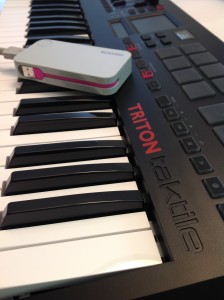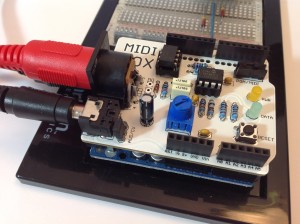The Korg Triton Taktile has a double personality. On one hand, the Triton Taktile (TT) is a MIDI controller with eight knobs, eight sliders, eight buttons, sixteen pads and a set of DAW function buttons. (These are the specs for the 49-key model, the model that I’m using.) On the other hand, it is a synthesizer with the Korg Triton classic sound engine. Right now, I’m playing the TT as a synth and I will be concentrating on the synth features.
The Sound On Sound review of the Korg Taktile controller (the model without the sound engine) is very well-written and I recommend reading the SoS article for more information about the TT’s control capabilities. I will say that Korg hit my major checkmarks for a controller: a 49-key keyboard with a good action, expression pedal input, sustain pedal input, and TA-DA, a 5-pin MIDI output in addition to the USB-B connector for power and computer/tablet communications. The TT will operate on a portable, rechargeable USB power pack (minimum 5V 1A output) and that is in fact how I’m using it in the studio. The picture below shows the Triton Taktile under battery power. The TT weighs just a little bit over 8 pounds (3.8kg) and is easy on the eyes as well as the back.
The TT connects to either headphones or external amp through a 3.5mm stereo jack. All of the connections are made through a panel on the right side of the TT. The output level is sufficient for comfortable listening on Roland RH-A7 headphones, my current choice for head gear.
As you might be aware already, you don’t get a full Triton classic. The TT is not multi-timbral and it does not have combinations (“combis” or layers) and insert effects. However, you can bring up one of 512 classic programs (voices) and play your heart out! There are two system-level master effects (MFX1 and MFX2) that are appropriate for the preset voice, e.g., chorus and reverb on electric piano. The TT is strictly a preset machine as program edits cannot be stored. This hasn’t cramped my act so far, but like any of the TT’s limitations, it could be a deal-breaker. You can save your favorite preset programs into two sets of favorites (set A and set B, each set with eight slots) for quick patch selection.
Hit the dedicated SOUND button to leave controller mode and go to synth mode. The current patch number and name are shown on the nice bright OLED display. Even though the OLED display is small, it is very readable. There are three ways to select a program:
- Press one of the program category buttons (assignable buttons F1 to F8). The TT selects the first program in the category or the last selected program in the category. It remembers the last selected program until power-off.
- Use the value slider (ribbon) to scroll through the programs. Tap the “+” or “-” at either end of the slider to increment/decrement, or slide your finger along the ribbon to move quickly to a new patch.
- Select one of your favorite programs from either set A or set B.
It takes a little practice to get the hang of the slider. Do not take this ax to a gig and expect to select patches on the fly! I recommend setting up favorites and getting the general layout of the patches before hand. Otherwise, an embarrassing epic fail will ensue.
The keyboard feels very good for a controller in this price range. It has a little more resistance than the Yamaha MOX series, for example. I find it quite comfortable to play — it does not feel like a toy. Korg claim that it is the same action as the Krome and I have no reason to doubt them. The pitch bend and modulation wheel also have a satisfying feel. The knobs and sliders are a little bit “light” to me. I don’t have an opinion on the pads as yet.
I enjoy playing this instrument! The knobs and sliders control eight parameters: volume, cutoff, resonance, attack, delay, release, MFX1 and MFX2. Cranking the cutoff and resonance is a real visceral thrill. The two master effects, unfortunately, are very subtle and understated. The TT cries out for a multi-effects unit with distortion and other sonic manglers.
My favorite sounds are the electric pianos, drawbar organs, church organs (!), strings, and acoustic guitar. Korg strings have always had a wonderfully expressive depth and these patches do not disappoint. The electric pianos are very clean. I threw a cheap Danelectro overdrive on the output in order to realize the EP’s full funked-up potential. Oh, for a multi-effects unit, Korg!
The brass isn’t too bad, especially the horns, cornet and flugelhorn. The TT’s woodwinds are pretty naff — yuck. My musical personality is split between liturgical church music and jazz/funk/60s rock. On the church side, I’m disappointed with the oboe, clarinet and other reeds. On the pop side, I don’t often venture into synth territory. However, the HipHopLead patch is great when you feel the urge for Herbie. There are a lot of lead and pad sounds to explore and I’m sure that I’ll find a few other useful patches.
The handbook in the box is helpful, but not sufficient. Be sure to download the parameter guide and the Triton Taktile-specific MIDI implementation chart. Korg could be a little more forthcoming about the MIDI implementation considering that the Taktile series are MIDI controllers for heaven’s sake. The full list of programs is at the absolute end of the parameter guide. I always look through the list of patches for a synth/workstation when considering a purchase and this list is somewhat hidden away at the end of the parameter guide.
Bottom line, I’m happy with the Triton Taktile even when its limitations are taken into consideration. It could be the heart of a light-weight, portable, battery-powered rig and I’m exploring that potential right now.


